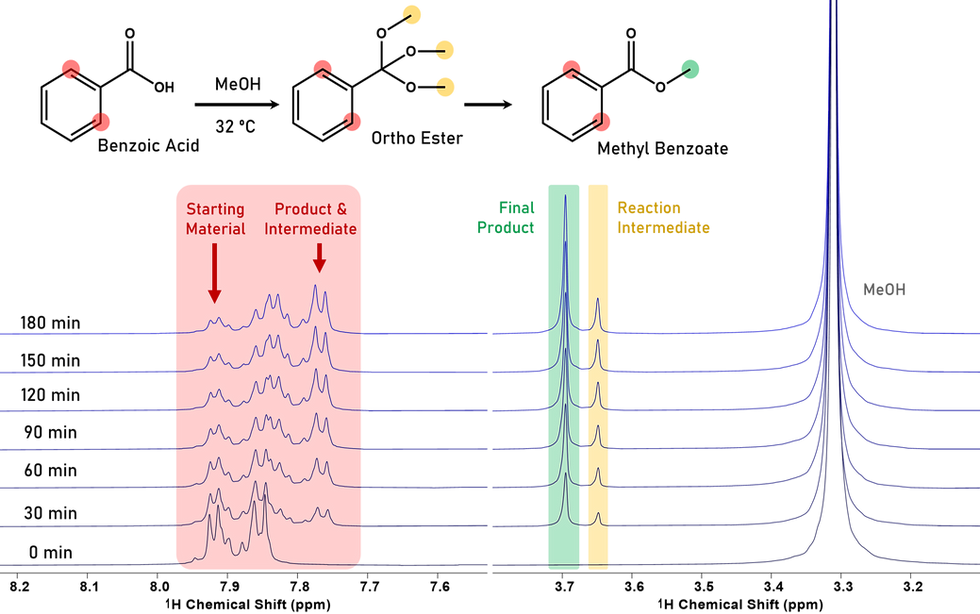There's a lot going on in nicotinamide at 125 MHz
- John Price

- Oct 10, 2021
- 3 min read
Updated: Nov 5, 2021
Nicotinamide appears on the World Health Organization’s model list of essential medicines as humanity’s go-to treatment for pellagra, a disease caused by severe deficiency of niacin, or vitamin B3. In the early 19th century, pellagra was a major public health problem in the southern United States. Nicotinamide is also sold as an acne treatment, and there is evidence that it reduces the risk of some kinds of skin cancer. The material used here came from a 500 mg capsule sold over-the-counter under the Nature’s Way brand. The capsule’s content was dissolved in 10 mL of water, then filtered, dried, and redissolved in deuterated solvents.
The proton NMR spectrum of nicotinamide has several interesting features, as revealed by the new Q Magnetics 125 MHz benchtop spectrometer. In the figure below, I show the aromatic region under three conditions: in D2O at neutral pH, in D2O with 2 drops of concentrated HCl added per mL, and in DMSO. The spectra are referenced to TMS in D2O and to DSS (set to 0.1 ppm) in DMSO.

125 MHz proton NMR spectra of nicotinamide in D2O, acidified D2O, and DMSO
The D2O spectrum at neutral pH is easiest to assign. Two of the multiplets are clearly broader than the others. These must be from the two protons adjacent to the fast-relaxing nitrogen [1]. The broad multiplet with the larger splitting must be H6, since it is adjacent to another proton, while the other broad multiplet must be H2. The remaining sharp multiplet with one large J-coupling must be H4, and the sharp multiplet with two large J-couplings must be H5. This assignment agrees with several in the literature [2,3].
The aromatic region changes dramatically when the D2O solvent is acidified by adding two drops of concentrated HCl per mL, so that the ring nitrogen becomes protonated (or rather deuterated, since there are many more exchangeable deuterons in the sample than exchangeable protons). The chemical shifts of the two ortho protons H2 and H6 increase by about 0.4 ppm, while H4 increases by 0.8 ppm and H5 by 0.7 ppm. As a result, the H4 and H6 multiplets are now overlapping. The smaller shift of the ortho protons is characteristic of pyridines [4]. By measuring the chemical shift of any of the ring protons versus pH, it is possible to determine pKa of the ring nitrogen, with the result pKa = 3.54. This experiment is simple enough that it can be included in a laboratory course [5].
When the spectrum is acquired in d6-DMSO, the H4 and H5 multiplets take on an odd asymmetric appearance. In a recent paper on methods development for qNMR, Achanta, Chen, and Pauli [3] show that this is due to overlap with two very broad peaks at 7.6 ppm and 8.2 ppm, assigned to the amide protons H7 and H8, and visible in DMSO because the solvent has no exchangeable protons.
Curiously, the ortho protons H2 and H6 that show broadening in D2O, seem to be sharper in both the DMSO and the acidified D2O spectra. This would seem to imply that the broadening in D2O is not due solely to fast quadrupolar relaxation of 14N.
References
1. J.P. Kintzinger and J.M. Lehn Mol. Phys. 14, 133 (1968).
2. BMRDB bmse000281, doi:10.13018/BMSE000281.
3. Prabhakar S. Achanta, Shao-Nong Chen, and Guido F. Pauli, Magn. Reson. Chem. 59, 746 (2021).
4. Mosher, Sharma, and Chakrabarty, J. Mag. Res. 7, 247 (1972).
5. Zivkovic et al., Magnetochemistry 3, 29 (2017).








Comments